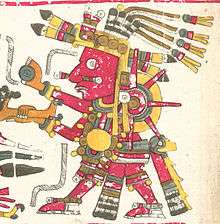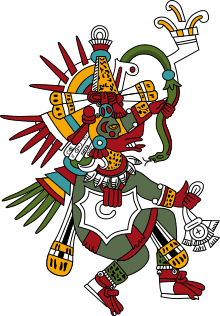Tōnatiuh

In Aztec mythology, Tonatiuh (Nahuatl: Ōllin Tōnatiuh [oːlːin toːˈnatiʍ] "Movement of the Sun") was the sun god.[1] The Aztec people considered him the leader of Tollan, heaven. He was also known as the fifth sun, because the Aztecs believed that he was the sun that took over when the fourth sun was expelled from the sky.
Description
Aztec theology held that each sun was a god with its own cosmic era, the Aztecs believed they were still in Tonatiuh's era. According to the Aztec creation myth, the god demanded human sacrifice as tribute and without it would refuse to move through the sky. It is said that 20,000 people were sacrificed each year to Tonatiuh and other gods, though this number is thought to be inflated either by the Aztecs, who wanted to inspire fear in their enemies, or the Spaniards, who wanted to vilify the Aztecs. The Aztecs were fascinated by the sun and carefully observed it, and had a solar calendar similar to that of the Maya. Many of today's remaining Aztec monuments have structures aligned with the sun.
In the Aztec calendar, Tonatiuh is the lord of the thirteen days from 1 Death to 13 Flint. The preceding thirteen days are ruled over by Chalchiuhtlicue, and the following thirteen by Tlaloc.
The iconography of Tonatiuh’s attire provides a visual explanation for what his role as the sun god entailed. The deity is usually depicted with arrows and a shield to show that he is a warrior. Tonatiuh often carries a maguey spine in one hand to signify that he takes part in bloodletting practices as a means of sacrifice. The importance of sacrifice is also reinforced by depictions of balls of eagle feather or the eagle itself, which were markers of sacrifice. Tonatiuh's connection to the sun leads us to believe that the eagle is a reference to the ascending and descending eagle talons, which is a visual metaphor for capturing the heart or life force of a person.[2] In some codices, a skull is placed on the end of his garments or on his leg, as a symbol of protection and to emphasize that Tonatiuh was a warrior. This could be a reference to the god, Xolotl. Xolotl was the god of lightning and death but was also responsible for protecting Tonatiuh during his journey into the underworld. He was depicted as a canine or the skeleton of a canine.[3] In fact, both gods are occasionally considered synonymous, due to syncretism with Nanahuatzin.[4]

See also
- Aztec calendar stone
- Five Suns
- Pedro de Alvarado (nicknamed Tonatiuh)
References
- ↑ Bingham, Ann (2004). South and Meso-American mythology A to Z. Infobase Publishing. p. 112. ISBN 0-8160-4889-4.
- ↑ Townsend, Richard (1979). State and Cosmos in the Art of Tenochtitlan. Washington D.C.: Dumbarton Oaks. p. 66.
- ↑ Unknown Mexica Artists. Codex Borbonicus. p. 16.
- ↑ Spence, Lewis (1994). The Myths and Legends of Mexico and Peru. Senate; New edition. ISBN 1-85958-007-6. p.93
